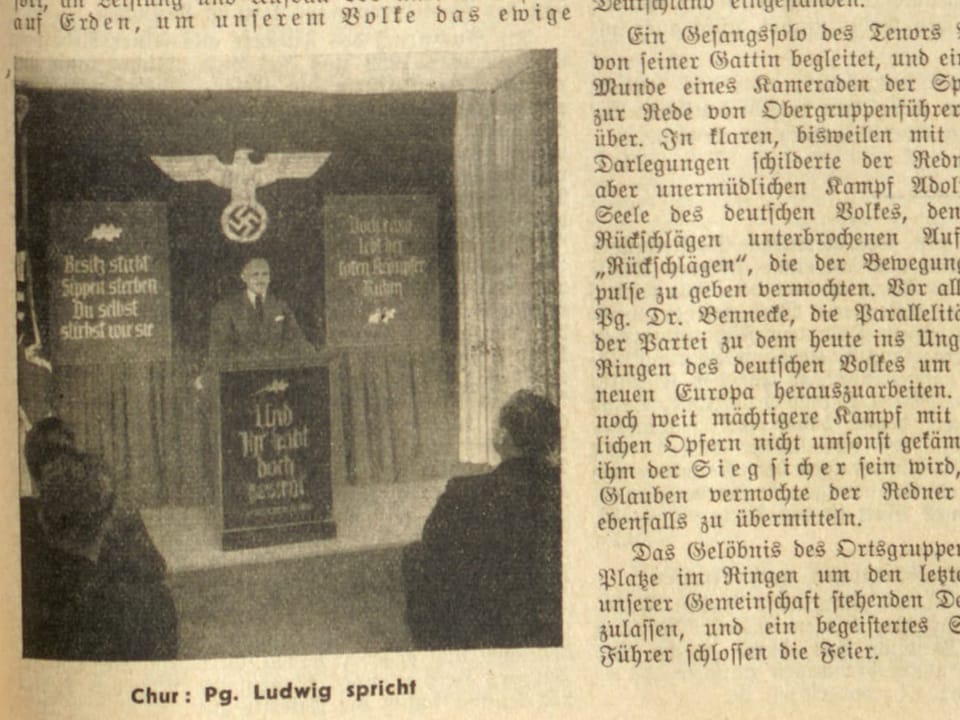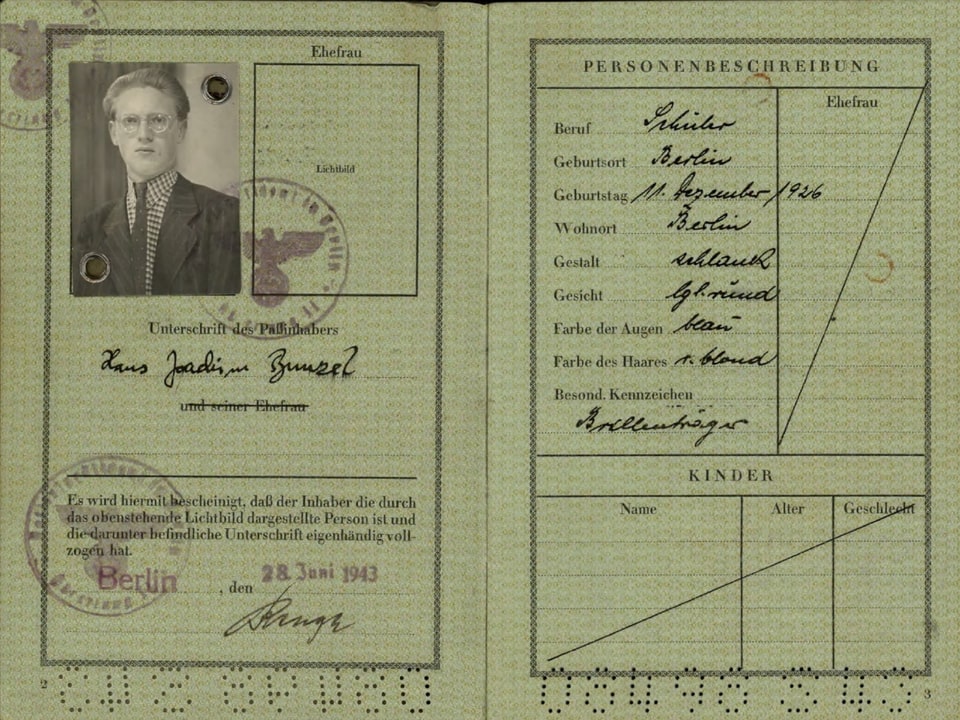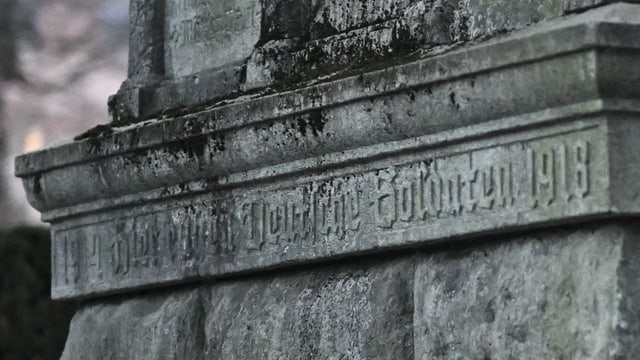The desire to educate people was great when SRF made public the existence of a Nazi memorial in Chur a year ago. Today the balance sheet is ambivalent. Historians and individual members of the Chur parliament criticize the historical assessment of the city of Chur: it is incomplete and not independent.
The city government will not correct the board.
The point of contention is the content of an information board that Chur wants to set up in the Daleu cemetery next to the Nazi memorial, as reported in detail by the SRF podcast “Zeitblende”.
Legend:
“The German grave monument”
Visualization proposal from the city of Chur for the information board next to the Nazi memorial.
City of Chur
Centrist politician and historian Tino Schneider said in the Chur city parliament in mid-April: “The information board avoids practically all critical questions.” Not only is a chapter on National Socialism in Chur missing, the board is also silent on the central question: “What did the Chur authorities at the time know, how did they behave towards the National Socialists?”
The Nazi context is downplayed
SRF presented the text of the information board to historian Martin Bucher, who researches the history of National Socialism in Switzerland. Bucher confirms that the text remains vague in many points: “This gives the impression that the city of Chur wants to trivialize the monument’s connection to National Socialism.”
For example, the introduction mentions an unnamed German institution that had the monument built. Historian Bucher criticizes that it is only at the end of the long text that it becomes clear that the client – the German War Graves Commission – was a staunchly National Socialist organization.

Legend:
Chur, November 9, 1941: Celebration in the “German Home”
Theodor Ludwig led, among other things, the NSDAP in Chur and was president of the local group of the German War Graves Commission.
ETH, Archives for Contemporary History, German newspaper in Switzerland
The role of the authorities at the time and the use of the monument on Third Reich holidays are also not taken into account. As SRF reported a year ago, grave wreaths with swastikas were laid at the cemetery in 1938.
No independent research
The critical votes in the Chur city parliament in mid-April had no effect. FDP City President Urs Marti rejected any changes to the information board. The reason: It is not up to politicians to judge the contemporary history of that time. This is the task of the historians: “The city government will not correct the board.” Parliament followed his lead and approved the information board in its unchanged form.
When asked, the mayor said that the text was written on behalf of the government by the former city archivist Ulf Wendler. The content was checked and approved by the Graubünden state archivist Reto Weiss and Andrea Kauer, the former director of the Rätisches Museum.
An internal clarification does not meet the criteria of fact-based and independent historical research.
Sacha Zala, President of the Swiss History Society, criticizes this approach: “Such an internal clarification does not meet the criteria of fact-based and independent historical research.”
It doesn’t matter how good this research is: “The suspicion is always that, in addition to scientific criteria, political considerations also played a role.” As with controversial legal questions, it is also crucial for historical investigations that independent external research is commissioned. A review by another authority is not enough.
The city of Chur’s approach protects against politics taking an active role in historiography.
He trusts the expertise of his employees, replies Mayor Urs Marti. With the review by the canton, the dual control principle was adhered to. The city of Chur’s approach carries a certain risk that some aspects will be less illuminated, “conversely, the city’s approach protects against politics taking an active role in historiography.”
A young Nazi lies in the monument
A year ago, the Chur government and parliament decided against further historical research. The city government stated in a report that the history of the monument has already been “comprehensively” examined: “Further research work is unlikely to provide any new insights into the history of National Socialism in Chur.”
The history surrounding the monument has already been comprehensively examined.
Now historian Martin Bucher came across a piquant detail during his investigations: a young National Socialist is also buried in the monument. The 19-year-old Hans Joachim Bunzel died in 1946, was buried in the Daleu cemetery and later reburied in the memorial, according to the information text. According to a Federal Council report from 1946, Bunzel was a member of the NSDAP, a Hitler Youth leader and “dangerous because of his Nazi fanaticism”. This is missing from the information board.

Legend:
“Dangerous because of his Nazi fanaticism”
19-year-old Hans Joachim Bunzel died of pulmonary tuberculosis in 1946 and was reburied in the memorial 20 years later, according to the information board. Bunzel had previously attended the “Fridericianum”, a National Socialist school, in Davos. The Federal Council wanted to expel him after the war, but he died beforehand.
Swiss Federal Archives
The point of contention is Nazi aesthetics
The question of what should be seen in the monument is also controversially discussed. The information board should state that the monument has been omitted from any clear National Socialist symbolism. The National Socialist context is therefore not easily recognizable.
The monument has a brutality that truly represents National Socialism.
“They made it too easy for themselves,” says German information designer Andreas Koop, author of a standard work on the appearance of National Socialism: “Something isn’t just National Socialist if it has a swastika on it.”
In terms of overall appearance, Koop speaks of a reserved “foreign version of National Socialism”. The theatricality and drama of this mini-mausoleum is outstanding: “The monument has a brutality that truly represents National Socialism.”
The historian is silent
The author and now retired city archivist Ulf Wendler does not want to comment publicly on criticism of the information board. The city archives subsequently announced that the information board had been approved by the city government and parliament.
In this context, Mayor Urs Marti emphasizes that he takes political responsibility. Regarding the accusation that the National Socialist context of the stone was trivialized on the information board, he said: “This was certainly not done consciously.” There are no files in the city archives on the role of the authorities at the time.
The Nazi stone is politically finished
Politician and historian Tino Schneider brought the Nazi stone onto the political stage in the city of Chur a year ago. He is disappointed with today’s result. There is a common thread running through the debate: “you walk through your own history with blinders on.”
For the city of Chur, the Nazi stone is a political matter. In mid-April, the city parliament commissioned the city to implement the information board. According to the city, it is still unclear when the information board will be installed.

